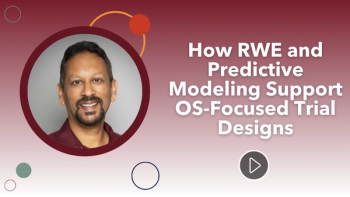
- Applied Clinical Trials-06-01-2019
- Volume 28
- Issue 6
The Benefits of RWD & RWE in Oncology Trials
C.K. Wang, MD, senior medical director at COTA Inc., discusses the impact of RWD and RWE in clinical oncology.
Applied Clinical Trials recently spoke with C.K. Wang, MD, senior medical director at COTA Inc., about the impact of real-world data (RWD) and real-world evidence (RWE) in clinical oncology. Wang is a medical oncologist who worked in private practice in Texas from 2006 to 2017 prior to joining COTA, which builds technology that analyzes data from thousands of real cancer patients to deliver clinically relevant insights. Wang also worked at IBM Watson Health in 2017 as a clinical adoption specialist and has since served as the acting deputy chief health officer for oncology/genomics and the global oncology leader for the Watson Health Clinical Adoption Team.
Q: As a practicing oncologist, what are your major challenges in finding the best treatments for your patients?
C.K. Wang: A very common challenge that I face is making treatment decisions and recommendations for a patient who is not well represented by any of the published clinical trial results. I am then left to extrapolate and assume that the results of the clinical trials are applicable and relevant to my patient who is often much older and had more medical comorbidities than the patients who were enrolled in clinical trials. A more fundamental challenge is my inability to answer straightforward and reasonable questions from my patients, including: “How many patients have you seen just like me?” or “What were their treatments and outcomes?” As oncologists, we are spending hours each day inputting information into electronic health records (EHRs); however, it is difficult to draw any real insights from this information. Coupled with the real-world limitations of clinical trials, this handicap adds to the complicated process that oncologists already face when trying to provide the best care for their patients.
Q: What is the role of real-world data as a comparator data in trials?
Wang: The role of RWD in clinical trials is growing as the FDA continues to voice its support for using RWD and RWE. There is increasing interest in using RWD to form “external control arms” in single-arm clinical trials to expedite the enrollment process and decrease the overall cost of clinical trials. Although there is some debate about whether external control arms should be used to establish the efficacy of a drug, there is no question that this approach might accelerate decisions to abandon ineffective drugs, an outcome that is good for patients and the healthcare system as a whole.
Another benefit of RWD and RWE is that they allow us to visualize the typical disease trajectory as well as identify potential patient populations that respond best to a certain therapy. Using RWD and RWE in this capacity can be particularly useful when studying rare diseases or rare subtypes of more common diseases.
Q: How does real-world evidence support physicians in understanding optimal treatment sequence?
Wang: The FDA is approving drugs at a rapid rate. These drugs are typically studied as standalones, meaning they are not studied in context to all of the other available drugs for a disease. This phenomenon is worsened by the delay from clinical trial conception to publication, during which time new drugs may have been approved by the FDA and have become part of standard-of-care therapy. This effectively leads to a phenomenon of a wealth of treatment options without clarity of when to best apply, combine, and sequence these treatments.
This is where RWE can be helpful. RWE unlocks hidden insights from patient data within EHRs that would otherwise be unavailable. Unlocking this information allows providers to see clinically similar patients and understand how they respond to treatments, either in combination with or in sequence to each other, as well as their associated outcomes. This allows for a clearer understanding of which treatment and/or sequence leads to the optimal outcome for a specific patient cohort. In this respect, RWE can bring a new level of clarity to cancer care by helping to delineate the right path to the optimal care.
Q: What makes COTA different from other oncology clinical data companies?
Wang: Many factors differentiate COTA from other oncology clinical data companies. First, COTA was founded by oncologists to help improve and transform cancer care. Our founder, himself a medical oncologist, realized that he, despite the wealth and depth of available EHR records, could not answer fundamental questions regarding his patient population. It was also out of this realization that established COTA’s second differentiating factor, the COTA Nodal Address (CNA). The CNA is a proprietary method of classifying patients and their disease into clinically similar groups by using a digital code. This is essentially a Dewey Decimal System for cancer care. The CNA allows providers and payers to uncover care delivery patterns and outcomes, as we have previously discussed, that are not easily available to them through other means.
More importantly, the clinical depth of COTA’s data is unmatched. With access to both academic and community-based cancer centers, COTA’s EHR agnostic technology-enabled and human abstraction process makes sense of all relevant aspects of the patient journey, including data in physician notes, pathology, radiology, surgical reports, genomic testing results, and referral documentation-to develop a longitudinal patient record and comprehensive picture of care.
At COTA, we put the patient at the center of everything we do because we believe that everyone touched by cancer deserves a clear path to the right care.
Articles in this issue
over 6 years ago
Master Protocol Guidance in Cancer R&D: Impact on Industryover 6 years ago
Glimpsing the Future of Clinical Trial Designover 6 years ago
FDA Facilitates Expanded Access for Cancer Drugsover 6 years ago
News Notesover 6 years ago
Applied Clinical Trials, June 2019 Issue (PDF)over 6 years ago
Navigating Drug Development Through More Turbulent Watersover 6 years ago
Building a Physician Referral Network: A Case Studyover 6 years ago
Reveling in 2018's Revealing Drug and Biologic ApprovalsNewsletter
Stay current in clinical research with Applied Clinical Trials, providing expert insights, regulatory updates, and practical strategies for successful clinical trial design and execution.






.png)



.png)



.png)
.png)
